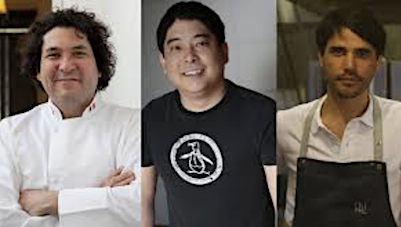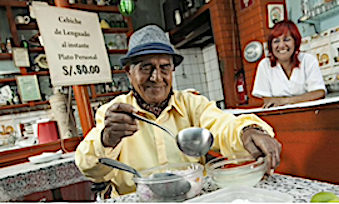Awards
All around the world Peru is acknowledged for her gastronomic achievements. Nowadays, children don't dream of becoming a football player, but of becoming a chef instead.
All around the world Peru is acknowledged for her gastronomic achievements. Nowadays, children don't dream of becoming a football player, but of becoming a chef instead.
For eight consecutive years, Peru has won the prize for World’s Best Culinary Destination (WTA) organised by the World Travel Awards. The WTA is a renowned institute that serves to acknowledge, reward and celebrate excellence across all sectors of the global travel and tourism industry.
There are about 50 species of corn, 2,000 varieties in potatoes, 650 species of fruit and so on. The cuisine is considered one of the most diverse in the world and is being recognised for its sophisticated flavours. There are three influences for this great diversity: a unique geography, a blend of races and cultures, and the incorporation of ancient cuisine into modern Peruvian cuisine. Thanks to its pre-Incas and Inca heritage and to Spanish, Basque, African, Sino-Cantonese, Japanese and finally French and Italian immigration (mainly throughout the 19th century), Peruvian cuisine combines the flavors of four continents. The ingredients and techniques of each of these culinary traditions have left a clear mark through time on the basic Inca diet, which primarily existed of corn, potatoes, ají and beans. The result of this 'fusion' of cuisines is a vast and colourful range of dishes, each telling it's own story.
Peruvian Pisco won over 20 gold medals and was named the best liquor of the world in the Concours Mondial de Bruxelles.
Annually, the world’s 50 best restaurants are ranked. In 2019, Peru scored really well again on the list. The top 10 includes two restaurants in Lima. At #6, Central by Virgilio Martinez (Central Restaurante, Mil), and at #10 Maido by Mitsuharu Tsumura. Both restaurants also are ranked #1 and #2 on the list of best restaurants of Latin America 2019.
Gastón Acurio is recipient of The World’s 50 Best Restaurants Diners Club Lifetime Achievement Award 2018. He is chef, cooking book author, business man and world's premier ambassador of the Peruvian cuisine as he put it on the world map with the culinary festival Mistura and his collaboration with Ferran Adrià. He has been awarded internationally as the "Entrepreneur of the Year" and owns several chains or restaurants all over the world (Astrid&Gaston Casa Moreyra, Cebicheria la Mar, Tanta, Panchita, Papacho's, Madam Tusan, Chicha, Barra Chalaca, El Bodegón). He is the founder father of Pachacútec Culinary Institute where he trains underprivileged students to become a cook. The school provides classes covering the history of Peruvian cuisine, kitchen techniques, nutrition, and English language. They also learn from great masters of Peruvian cuisine, who are guest teachers at the school.
A list of famous deceased maestro chefs in Peru: Nisei Humberto Sato (Costanera 700, he was one of the first Nikkei chefs), Teresa Izquierdo (El Rincón que no Conoces), Toshiro Konishi (Toshiro’s and Wako, he was a Nikkei pioneer and came to peru to work with Nobu). They all received life-time achievement awards.
A list of nowadays famous chefs: Anthony Vazquez (chef La Mar in Lima, San Francisco and Argentina), Flavio Solorzano (El Señorío de Sulco and he is the founder of festival Mistura), Giancomo Bocchio (Wallqa Restaurante), Hectór Solís (Fiesta), Jaime Pesaque (Mayta), Javier Ampuero (Limeño, Ampuero Cocina Bar), Javier Wong (Chez Wong), José Andrés (World Central Kitchen), José de Castillo (la Isolina), Luis Armando "Cucho' la Rosa (La Casa de Don Cucho), Pedro Miguel Schiaffino (Malabar and M/V Aqua, he is famous as the jungle chef), Palmiro Ocampo (Huevón), Rafael Osterling (Rafael, El Mercado, Felix Brasserie), Rafael Piqueras (Maras), Renato Peralta (Eggo Bread & Breakfast), Teresa Ocampo (Donde Teresa, she is the first TV chef), Tomás Matsufuji (Al Toke Pez).

In memory the best cevichero in the world: Pedro Solari (1922-2020). He is considered as the father of the modern ceviche. When he was only twelve years old, his mother was running behind in preparing a lunch for guests, so he offered to make the ceviche. At the time, ceviche was marinated for hours or a day. But the guests already were arriving, so Pedro threw together fish, lime juice, ají limo, onions and salt, left it to marinate and served it five minutes later. Everyone was blown away and unintentionally he had invented modern ceviche. For more than eighty years, Pedro prepared each bowl of ceviche in his cevicheria in Lima. Being a pioneer in the gastronomy of Peru long before Peru was recognised as a culinary country, he received many Peruvian presidents and other celebrities in his restaurant. He taught many famous chefs how to make proper ceviche, such as Javier Wong and Toshiri Konishi. His famous words “Whoever hasn’t eaten my food, is screwed”. May Pedro rest in peace.
